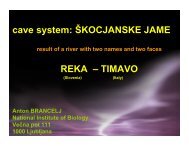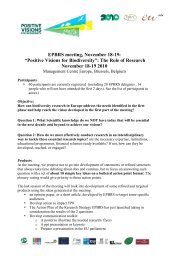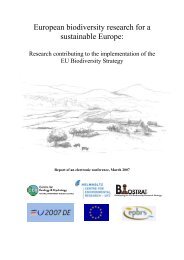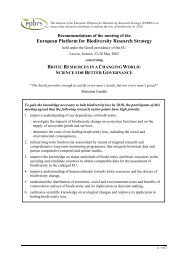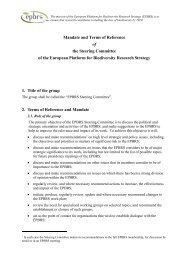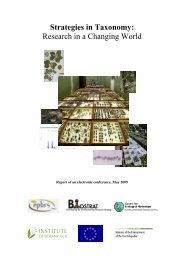Evaluation of the effectiveness of the New Instruments of ... - CORDIS
Evaluation of the effectiveness of the New Instruments of ... - CORDIS
Evaluation of the effectiveness of the New Instruments of ... - CORDIS
You also want an ePaper? Increase the reach of your titles
YUMPU automatically turns print PDFs into web optimized ePapers that Google loves.
1. Executive Summary<br />
An independent Panel <strong>of</strong> high-level experts, chaired by Pr<strong>of</strong>essor Ramon Marimon, has<br />
evaluated <strong>the</strong> <strong>effectiveness</strong> <strong>of</strong> <strong>the</strong> <strong>New</strong> <strong>Instruments</strong> introduced in <strong>the</strong> Sixth Framework<br />
Programme (FP6). This evaluation is based on information deriving from <strong>the</strong> first calls for<br />
proposals and feedback received from participants. Key recommendations are as follows:<br />
1. The <strong>New</strong> <strong>Instruments</strong> introduced in FP6 are a powerful means to foster transnational<br />
collaborative research in <strong>the</strong> European Research Area (ERA). Moreover, too much<br />
discontinuity is detrimental with respect to o<strong>the</strong>r forms <strong>of</strong> public and private funding. The<br />
<strong>New</strong> <strong>Instruments</strong> should <strong>the</strong>refore be maintained in FP7. There are however many<br />
design and implementation aspects that need to be improved, possibly already during<br />
FP6.<br />
2. The European Commission should clearly classify instruments according to <strong>the</strong> goals to<br />
which <strong>the</strong>y are expected to contribute, establish clear guidelines and criteria for <strong>the</strong>ir use<br />
and communicate <strong>the</strong>m to <strong>the</strong> participants to help <strong>the</strong>m prepare <strong>the</strong>ir proposals.<br />
3. The European Commission should specify <strong>the</strong> portfolio <strong>of</strong> <strong>Instruments</strong> available and <strong>the</strong><br />
strategic objectives. Participants should define <strong>the</strong> specific research objective <strong>the</strong>y will<br />
pursue and why this can best be met by <strong>the</strong> Instrument <strong>the</strong>y have chosen.<br />
4. It is a common misconception that <strong>the</strong> <strong>New</strong> <strong>Instruments</strong> should be very large. “Critical<br />
mass” depends on <strong>the</strong> topic, <strong>the</strong> <strong>the</strong>matic area, <strong>the</strong> participants and <strong>the</strong> potential impact<br />
and added value. The concept <strong>of</strong> 'one size fits all' should not be applied across all<br />
<strong>the</strong>matic areas and <strong>Instruments</strong>. Participants should justify in <strong>the</strong>ir proposal <strong>the</strong> way <strong>the</strong>y<br />
have built <strong>the</strong>ir consortium to reach <strong>the</strong> adequate critical mass.<br />
5. Networks <strong>of</strong> Excellence (NoEs) have met with a significant level <strong>of</strong> criticism but <strong>the</strong><br />
general concept <strong>of</strong> structuring and streng<strong>the</strong>ning <strong>the</strong> ERA has been well appreciated.<br />
Problems with <strong>the</strong> processes need attention but <strong>the</strong> major problem has been <strong>the</strong> concept<br />
<strong>of</strong> “durable integration”. NoEs should be designed as an instrument to cover different<br />
forms <strong>of</strong> collaboration and different sizes <strong>of</strong> partnerships.<br />
6. Integrated Projects (IPs) have gained general approval but, as with NoEs, processes<br />
such as consortia-building, proposal submission, proposal evaluation and contract<br />
negotiation need to be improved. The concept that Integrated Projects are primarily<br />
concerned with delivering new knowledge and competitive advantage to European<br />
industry needs to be emphasised. As IPs and Specific Targeted Research Projects<br />
(STREPs) have many common characteristics, <strong>the</strong> differences between <strong>the</strong>se<br />
<strong>Instruments</strong> should be clarified.<br />
7. A greater role must be played by <strong>Instruments</strong> such as STREPs and small consortium<br />
IPs. Such instruments are better adapted to risk-taking, industry, participants from new<br />
Member States and to smaller players in general. Their role for <strong>the</strong> research community<br />
is essential. This must be reflected in a substantial increase in <strong>the</strong> total share <strong>of</strong> <strong>the</strong><br />
budget finally allocated to STREPs in future calls <strong>of</strong> FP6 and in <strong>the</strong> future FP7.<br />
8. Emerging groups should be attracted ra<strong>the</strong>r than discouraged from participation. The<br />
best research groups and <strong>the</strong> most innovative firms should be attracted since <strong>the</strong>y must<br />
play a leading role in structuring <strong>the</strong> ERA.<br />
3



